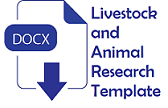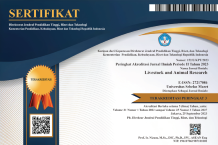Near infrared spectroscopy for the quality control of rice bran
Abstract
Objective: The objective of this study was to examine the accuracy of estimating the nutrient content in rice bran as a feed ingredient by using Near Infrared (NIR) technology compared to proximate analysis method.
Methods: Rice bran was used as feed sample to compare the results of data analysis using these two methods. In this study the Fourier Transform Near-infrared used infrared with wavelength of 12500-4000 cm-1. The OPUS 7.8 software was integrated with NIRS. The model was made by using Partial Least Square regression analysis to correlate the result of the spectrum and the result of proximate analysis method.
Results: In this study, the nutrient content in rice bran available in markets, which commonly are Crude Protein (CP), ether extract (EE), and Crude Fiber (CF), are quite varied and wide in range, so that The curve prediction/true showed up wider and did not cover the entire surface of the line. In consequence two outliers were removed so that the accuracy value could be increased in measuring the quality of animal feed as indicated by the improvement of the coefficient of determination or R2, Root Mean Square Error for Cross Validation (RMSECV), and Standard Error (SE).
Conclusions. NIR is a useful tool to estimate nutrient composition of rice bran available in the market especially for CP, EE, and CF by removing two outliers. The Prediction / True curve does not widen after removing two outliers, and can improve R2, RMSECV, and SE values.
Keywords
Full Text:
PDFReferences
- Zare-Sheibani, A. A., M. Arab, M. J. Zamiri, M. R. Rezvani, M. Dadpasand, and F. Ahmadi. 2015. Effects of extrusion of rice bran on performance and phosphorous bioavailability in broiler chickens. J. Anim. Sci. Technol. 57(1): 2–6. Doi: 10.1186/s40781-015-0059-z
- Directorate General of Livestock and Animal Health. 2018. Livestock and Animal Health Statistics. Jakarta.
- Nurhayu, A. and A. Ella. 2019. Dedak padi sebagai campuran pakan untuk ayam kampung unggul Balitbantan (KUB). Bul. Inov. Teknol. Pertan.15: 9–14.
- Stein, H. H., G. A. Casas, J. J. Abelilla, Y. Liu, and R. C. Sulabo. 2015. Nutritional value of high fiber co-products from the copra, palm kernel, and rice industries in diets fed to pigs. J. Anim. Sci. Biotechnol. 6(1):1–9. Doi:10.1186/s40104-015-0056-6
- Salami, S. A. et al. 2019. Sustainability of feeding plant by-products: A review of the implications for ruminant meat production. Anim. Feed Sci. Technol. 251:37–55. Doi:https://doi.org/10.1016/j.anifeedsci.2019.02.006
- Sanchez, J., A. Thanabalan, T. Khanal, R. Patterson, B. A. Slominski, dan E. Kiarie. 2019. Growth performance, gastrointestinal weight, microbial metabolites and apparent retention of components in broiler chickens fed up to 11% rice bran in a corn-soybean meal diet without or with a multi-enzyme supplement. Anim. Nutr. 5:41–48. Doi:https://doi.org/10.1016/j.aninu.2018.12.001
- Wibawa, A. A. P., I. W. Wirawan, dan I. B. G. Pratama. 2015. Peningkatan Nilai Nutrisi Dedak Padi sebagai Pakan Itik melalui Biofermentasi dengan Khamir. Majalah Ilmiah Peternakan. 18(1): 11–16. Doi: https://doi.org/10.24843/MIP.2015.v18.i01.p03
- Nurcahyani, D. T., S. Wulandari, and S. Nusantoro. 2017. Pengaruh pemberian dedak kasar fermentasi pada domba ekor tipis sebagai bahan baku konsentrat. J. Ilmu Peternak. Terapan. 1(1):17–24. Doi:10.25047/jipt.v1i1.532
- Wulandari, S., T. M. Syahniar, dan S. Nusantoro. 2020. Can near infrared spectroscopy (NIRS) quantify the quality of fishmeal circulating in Jember, Indonesia?,” IOP Conf. Ser. Earth Environ. Sci. 411:1-6. Doi :10.1088/1755-1315/411/1/012039
- Galasso, H. L., M. D. Callier, D. Bastianelli, J. P. Blancheton, and C. Aliaume. 2017. The potential of near infrared spectroscopy (NIRS) to measure the chemical composition of aquaculture solid waste. Aquaculture. 476:134–140. Doi:10.1016/j.aquaculture.2017.02.035
- Ingle, P. D., Christian, R., Purohit, P., Sarraga, V., and Handle, E. 2016. Determination of protein content by NIR spectroscopy in protein powder mix products. J. AOAC Int. 99(2): 360–363. Doi: 10.5740/jaoacint.15-0115
- AOAC. 2005. Official methods of analysis of AOAC international. 18th ed. Maryland: AOAC International.
- Manley, M., 2014. Near-infrared spectroscopy and hyperspectral imaging: Non-destructive analysis of biological materials. Chem. Soc. Rev. 43(24): 8200–8214. Doi: 10.1039/c4cs00062e
- Elfadl, E., C. Reinbrecht, and W. Claupein. 2010. Development of near infrared reflectance spectroscopy (NIRS) calibration model for estimation of oil content in a worldwide safflower germplasm collection. Int. J. Plant Prod. 4(4): 259–270. Doi: https://www.researchgate.net/publication/268056951
- SNI (Standar Nasional Indonesia). 2013. Dedak padi-Bahan pakan ternak [Internet]. Badan Standardisasi Nasional. ICS 65.120. [cited 2019 Des 1]. Available from: http://pakan.ditjenpkh.pertanian.go.id/wp-content/uploads/2019/08/SNI-3178-2013-Dedak-padi-Bahan-pakan-ternak.pdf
- Omotoso, O. B., T. A. Arilekolasi, and A. N. Fajemisin. 2019. Study on mineral, antinutrient and blood parameters of goats fed molasses treated rice husk. J. Food, Nutr. Agric. 2(1): 10-19. Doi:10.21839/jfna.2019.v2i1.236
- Wulandari, S., A. Agus, M. N. Cahyanto, and R. Utomo. Effect of fermented cacao pod supplementation on sheep rumen microbial fermentation. J. Indones. Trop. Anim. Agric. 39(3):167–174. Doi: 10.14710/jitaa.39.3.167-174
- Parrini, S., A. Acciaioli, A. Crovetti, and R. Bozzi. 2018. Use of FT-NIRS for determination of chemical components and nutritional value of natural pasture. Ital. J. Anim. Sci.17(1):87–91. Doi:10.1080/1828051X.2017.1345659
- Yang, Z., G. Nie, L. Pan, Y. Zhang, L. Huang, X. Ma, X. Zhang. 2017. Development and validation of near-infrared spectroscopy for the prediction of forage quality parameters in Lolium multiflorum. 5:1-20. Doi: 10.7717/peerj.3867
- Andrade, C. 2020. Understanding the difference between standard deviation and standard error of the mean, and knowing when to use which. Indian J. Psychol. Med. 42(4): 409–410. Doi: 10.1177/0253717620933419
- Cozzolino, D., W. U. Cynkar, N. Shah, and P. Smith. 2011. Multivariate data analysis applied to spectroscopy: Potential application to juice and fruit quality. Food Res. 44(7):1888–1896. Doi:10.1016/j.foodres.2011.01.041
- Nicolaï, B. M., K. Beullens, E. Bobelyn, A. Peirs, W. Saeys, K. I. Theron, J. Lammertyn. 2007. Nondestructive measurement of fruit and vegetable quality by means of NIR spectroscopy: A review. Postharvest Biol. Technol. 46(2):99–118. Doi: 10.1016/j.postharvbio.2007.06.024
- Berzaghi, P. dan R. Riovanto. 2009. Near infrared spectroscopy in animal science production: Principles and applications. Ital. J. Anim. Sci. 8(3):39–62. Doi:10.4081/ijas.2009.s3.39
- Prieto, N., O. Pawluczyk, M. E. R. Dugan, and J. L. Aalhus. 2017. A Review of the principles and applications of near-infrared spectroscopy to characterize meat, fat, and meat products. Appl. Spectrosc.71(7):1403–1426. Doi: 10.1177/0003702817709299
- Handayani, P. A., E. Nurjanah, and W. D. P. Rengga. 2015. Pemanfaatan Limbah Sekam Padi Menjadi Silika Gel. J. Bahan Alam Terbarukan. 3(2):55–59. Doi: 10.15294/jbat.v3i2.3698
Refbacks
- There are currently no refbacks.










